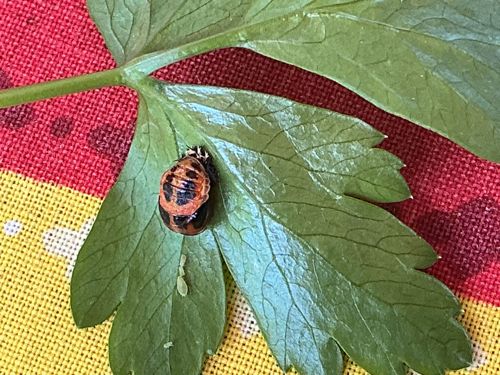Ladybug Pupa (likely a Convergent Lady Beetle or a multi-colored Asian lady beetle)
Scientific Name: Coccinellidae (Pupa Stage), possibly Hippodamia convergens or Harmonia axyridis based on common species and markings.
Order & Family: Order: Coleoptera, Family: Coccinellidae
Size: As a pupa, they are typically 4-8 mm long, often slightly smaller than the adult beetle. Adult ladybugs range from 1 mm to 10 mm in length depending on species, with many common species being 5-8 mm.

Natural Habitat
Ladybugs are found in a wide variety of habitats where their prey (aphids and other soft-bodied insects) are abundant. This includes gardens, agricultural fields, meadows, forests, and urban green spaces. They are commonly seen on plants, particularly those infested with aphids.
Diet & Feeding
The diet of the ladybug changes throughout its life cycle. Ladybug larvae (the stage before the pupa) and adult ladybugs are primarily predatory, feeding on soft-bodied insects like aphids, scale insects, mites, and other small pest insects. They are voracious predators in their larval and adult stages.
Behavior Patterns
This image shows a ladybug pupa. Ladybugs undergo complete metamorphosis, which includes four stages: egg, larva, pupa, and adult. The pupal stage is inactive and is typically attached to a leaf or stem, where it transforms from a larva into an adult ladybug. The pupa may twitch if disturbed. Adult ladybugs are often solitary or found in small groups, particularly when overwintering.
Risks & Benefits
Ladybugs are overwhelmingly beneficial insects, particularly in agriculture and gardening. They are natural predators of many common crop pests, such as aphids, which helps to control pest populations without the need for chemical pesticides. This makes them valuable for integrated pest management (IPM). Some species, like the Multicolored Asian Lady Beetle, can become a nuisance when they overwinter in homes, but generally, their benefits significantly outweigh any minor risks.
Identified on: 8/18/2025